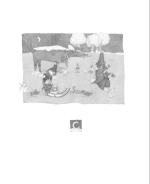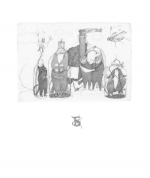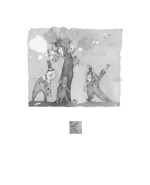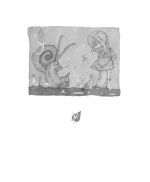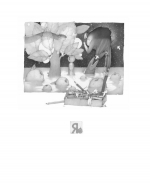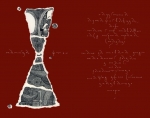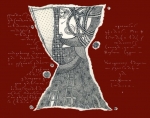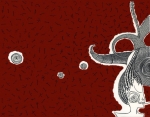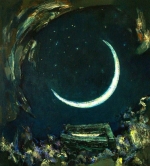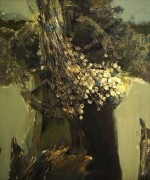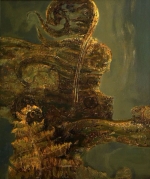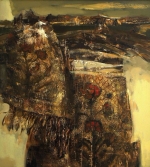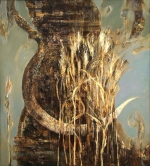Author: Ekatherina Kenigsberg.
Every year the graphic department of the Belarusian State Academy of Arts graduates a few specialists. There are specific features of graphic artists studding, such as the focus on book and easel graphics, individual attention to each student, striving for developing a creative potential of each student. It makes the process of their training unique.
In 2011 6 specialists graduated from the department. The graduation projects of four artists are worth great attention.
The graduation project by Anastasia Sokolovskaya is named "Alphabet"*. The author was attracted by the idea of presenting ordinary letters in some unusual decorative way. The series made in pencil consists of five sheets, each sheet shows one Russian letter (Ń, —, ”, , Ŗ).
The letter Ń is twins contained in a bottle. Three out of four bottles, drawn in a sheet of paper, are filled with the twins. And one couple is hugging each other Ė they are Siamese twins. Another couple is twins stitched together, but they try to get rid of each other. One more couple is shown as twins turned back to each other, but they are tied together with the tips of their hats. A cat, which is in the fourth bottle, is watching in a philosophical manner everything round him.
The letter C is curved sled runners and as well as a waving scarf around the neck of one of the boys on the sled. The sled is pulled by a dog, hunting a bone. A winter landscape shows all children's plays: skates, sleds, snowballs, walking the dog.
The letter ” is a snail. Or their surprising diversity exactly: there is a snail-deer, a snail-leaf and a snail-cat.
The letter K is, of course, a cat. The bandit-cat which has caught a bird. But the cat himself was caught by a bully, one more bully has pressed another cat to the tree. At the top of the tree a pack of cats is under the invasion.
The letter Ŗ is presented as apples in the Garden of Eden. The letter itself is a human figure, who is passing into another world.
All the illustrations are full of delicate, friendly humor. They are expressive and rich in narrative details. Each sheet is an individual and finished work of art. Every illustration has its own ethical and philosophical meaning. Perhaps the series will be even more interesting for adults than for children.
The graduation project by Nadezhda Makeeva is a series of 5 sheets they are "The portraits of mythological creatures." Two works are printed in lithography workshop, three works are drawn in a pencil simulating lithographic.
Each sheet is a single portrait of a mythological creature found in Belarusian folklore. All the characters are shown in their usual environment: Kikimora lives in the forest, Were-animal flies over the ground, Pan is hiding in the swamp, Water sprite lives in the pond or river, Rusting occupies a quagmire. Imaginary, over-emphasized details of the creatures bodies gain the effect. Sometimes it seems that the artistís made the sketches from real objects, as their traits are shown so perfectly.
The topic of the project and technical specific stress the originality of the works. The illustrations of the series are logically arranged. Thanks to common style and composition they are absolutely finished works.
The graduation project by Vera Yagovdik is some illustrations for the book written by Valzhina Mort. The name of the book is "Utopia". It consists of a single poem. This poem is quite difficult to understand as it has many connotations and nuances. One can discover them over and over when reading the book. To Illustrate a book of such sort is a very difficult task for an artist.
Five illustrations and two endpapers of the book are in the linocut technique. The combination of some symbolic elements and images is a result of creative and technical experiments. There is a silhouette of an hourglass practically in every picture. In these silhouettes one can find the fragments of a road-ladder, turning into a snake. The hourglass, the road, the steps, the snake symbolize eternal value (time, wisdom and eternity) and counterpoise impermanent, airy and utopian nature of fantasies. A red background and a complex white print for the poetic lines are chosen to stress alarming and irregular rhythm of the poem. The jagged torn edges of the illustrations intensify the impression.
Each sheet has a finished composition; all parts of the book are in harmony. The general compositional structure suits the poem. The works are originally treated; the authorís left her bright and individual mark on her creations. The Illustrations are worth examining over and over, every time you are sure to find something new.
Vera Yagovdik managed to create a special book, as itís a combination of poetessís and artistís ideas.
The graduation project by Dmitry Asadchy (the student of the graphic department) is painted in oil on canvas. Itís a unique episode in the history of the department. As the graduate of the graphic department displays his pictorial works as the graduation project. "My Land" is the name of a series of five canvases. Each work has its own story and its name. "The treasure of Kupalle" takes the viewers into the mysterious atmosphere of midsummer night. The leaves of fern, as if made of gold, are gently turning into the deck of a violin. A grey background serves damped music.
A picture "Everlasting" is dedicated to the eternal value - bread. The sickle and the ears of wheat are the symbols of the circle of life. Light grey, silver and golden colours emphasize optimistic and positive mood.
ďThe Chandelier of the skyĒ looks like a twisted, spiral abyss. The new moon and the stars are looking at the dark water, a well is dreaming in the bushes of white and purple lilacs. The deep color of the water or the reflection of the sky draw and attract.
ďWinter-crops in the ploughed field" is like an anthem for Belarus. Mild golden ornaments and red flowers on Slutsk belts are turning into the landscape typical for Northern Belarus. It is distinguished by pale colors of woods and lakes.
ďCircle of life" shows the Belarusian flax in the form of icon. The stems and the flowers are clearly drawn, a spinning wheel is blurred and turning into a cross. A multi-aspect of images deepen the symbolism of the work.
The composition of the work seems first fragmented. But the method was deliberately chosen to emphasize that every moment of life, holiday or everyday life, is valuable and meaningful. The harmony in structure and form makes them easy to take.
The Belarusian State Academy of Arts is a source of new ideas, technologies and innovations. The density of the best creative representatives, the connection between generations, individual attention to each student create a special atmosphere where a great number of creative personalities are trained. The process of education in the Academy is not just concentrated in its murals. The students take part in exhibitions, open-airs, conferences in Belarus and abroad; visit the exhibitions in Belarus, attend the shows and master classes of foreign and native artists, keep up with the most interesting art events on the Internet. While they are studying for six years their personality and unique style are being formed. Their graduation works is the final result, the transfer to another level. The art of young artists is often ahead of time, the art is not always observes the laws of the real world. The new works by Vera Yagovdik, Dmitry Asadchy, Anastasia Sokolovskaya and Nadezhda Makeeva are sure to draw the attention of people because these works present some unusual view at the usual world.
* Cyrillic alphabet used in Russian language. Most of used images in Russian language start with that letters.
